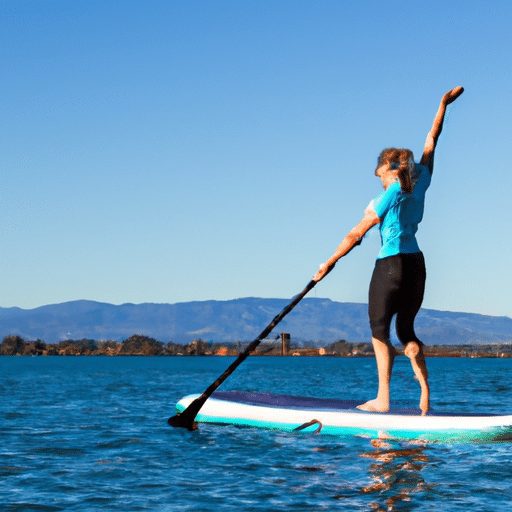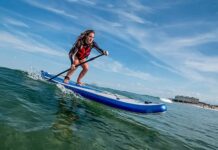The name says it all – we’re here to talk about some great SUP fitness exercises for your back! If you’re looking to strengthen and tone your back muscles while enjoying some time out on the water, then you’ve come to the right place. Stand-up paddleboarding (SUP) has quickly become a popular activity for fitness enthusiasts, and it’s no surprise why. Not only does it provide a fun and refreshing way to get exercise, but it also offers a unique challenge to your core and back muscles. So, grab your paddle and let’s explore some fantastic exercises to keep your back strong and healthy while paddling away!
Stretching Exercises
Seated Spinal Twist
One of the best ways to relieve tension in the back and increase flexibility is by practicing the seated spinal twist. To perform this exercise, start by sitting on your SUP board with your legs extended in front of you. Bend your right knee and place your right foot on the outside of your left thigh. Then, twist your upper body to the right, placing your left elbow on the outside of your right knee. Hold this position for 30 seconds and then switch sides. The seated spinal twist not only stretches the muscles in your back but also improves digestion and detoxification.
Child’s Pose
The child’s pose is a gentle and relaxing stretch that targets the entire back, including the lower back. Start by kneeling on your SUP board with your knees hip-width apart. Sit your hips back, lowering your buttocks towards your heels. Extend your arms in front of you as you walk your hands forward, bringing your chest closer to the board. Allow your forehead to rest on the board and relax into the pose. Hold this position for 1-2 minutes, taking slow and deep breaths. The child’s pose helps release tension in the back, reduces stress, and promotes a sense of calm.
Cat-Cow Stretch
The cat-cow stretch is a dynamic movement that stretches and mobilizes the spine while also engaging the core muscles. Start by getting on your hands and knees on your SUP board, with your wrists aligned under your shoulders and your knees under your hips. Begin the movement by arching your back towards the sky, dropping your head towards the ground, and pulling your belly button towards your spine. This is the cow position. From there, reverse the movement by rounding your back, tucking your chin towards your chest, and drawing your belly button towards your spine. This is the cat position. Alternate between the cow and cat positions for 10-15 repetitions. The cat-cow stretch helps improve spinal flexibility and posture, relieving tension in the back.
Core Strengthening Exercises
Plank
The plank is a classic exercise that targets the core muscles, including the muscles in the back. To perform the plank on your SUP board, start by kneeling on the board and place your forearms on the board, shoulder-width apart. Extend your legs behind you, resting on the balls of your feet. Engage your core and glutes to maintain a straight line from your head to your heels. Hold this position for 30-60 seconds, focusing on breathing deeply. The plank not only strengthens the muscles in your back but also improves stability and posture.
Side Plank
The side plank is a variation of the plank that specifically targets the oblique muscles, which are important for spinal stability. To perform the side plank on your SUP board, start by lying on your side and propping yourself up on your forearm, with your elbow directly under your shoulder. Stack your feet on top of each other and engage your core to lift your hips off the board. Maintain a straight line from your head to your heels and hold this position for 30-60 seconds on each side. The side plank helps strengthen the muscles in your back and improve lateral stability.
Superman
The superman exercise is a great way to target the muscles in your lower back. To perform the superman on your SUP board, start by lying on your stomach with your arms extended in front of you and your legs straight behind you. Simultaneously lift your arms, chest, and legs off the board, engaging the muscles in your back. Hold this position for a few seconds and then lower back down. Repeat for 10-15 repetitions. The superman exercise helps strengthen the muscles in your back and improves spinal extension.
Upper Back Exercises
Reverse Snow Angels
The reverse snow angels are a fantastic exercise for targeting the muscles in your upper back and shoulders. To perform this exercise on your SUP board, lie on your stomach with your arms extended overhead, palms facing up. Lift your chest, arms, and legs off the board while keeping your gaze towards the ground. As you lift, open your arms out to the sides, as if you were making a snow angel in reverse. Squeeze your shoulder blades together at the top of the movement and then lower back down. Repeat for 10-15 repetitions. The reverse snow angels work the muscles in your upper back, improving posture and shoulder mobility.
Resistance Band Rows
Resistance band rows are an effective way to strengthen the upper back muscles while also engaging the core. To perform this exercise on your SUP board, attach a resistance band to an anchor point on the board and hold the handles in each hand. Stand on the board with your feet hip-width apart and knees slightly bent. Bend forward at the hips, keeping your back straight, and extend your arms out in front of you. Pull the bands towards your chest, squeezing your shoulder blades together and keeping your elbows close to your body. Slowly release back to the starting position and repeat for 10-15 repetitions. Resistance band rows help improve posture and strengthen the muscles in your upper back.
Lower Back Exercises
Bridge Pose
The bridge pose is an excellent exercise for targeting the muscles in your lower back, buttocks, and hamstrings. To perform this exercise on your SUP board, lie on your back with your knees bent and feet flat on the board, hip-width apart. Place your arms down by your sides, palms facing down. Engaging your core and glutes, press your feet into the board and lift your hips towards the sky. Hold this position for a few seconds and then slowly lower back down. Repeat for 10-15 repetitions. The bridge pose helps strengthen the muscles in your lower back and improve hip mobility.
Pelvic Tilt
The pelvic tilt exercise is a simple yet effective way to engage and strengthen the muscles in your lower back. To perform this exercise on your SUP board, start by lying on your back with your knees bent and feet flat on the board, hip-width apart. Place your hands on your hips. Initiate the movement by tilting your pelvis forward, flattening your lower back against the board. Hold for a few seconds and then return to the starting position. Repeat for 10-15 repetitions. The pelvic tilt exercise helps improve spinal alignment and strengthen the muscles in your lower back.
Balance and Stability Exercises
Tree Pose
Tree pose is a yoga posture that challenges your balance and strengthens the muscles in your legs and core. To perform this pose on your SUP board, start by standing with your feet together and your arms down by your sides. Shift your weight onto your left leg and bring the sole of your right foot to rest against your left inner thigh or calf. Find a focal point to fix your gaze on and bring your hands together at the center of your chest. Hold this position for 30 seconds to 1 minute and then switch sides. Tree pose improves balance, stability, and concentration.
Single-Leg Squats on the SUP Board
Single-leg squats are a great exercise for targeting the muscles in your legs, hips, and core while also challenging your balance. To perform single-leg squats on your SUP board, stand with your feet hip-width apart and your arms out in front of you for balance. Lift your right foot off the board and extend it in front of you. Keep your upper body upright and slowly lower into a squat, bending your left knee and pushing your hips back. Pause at the bottom, and then push through your left foot to return to the starting position. Repeat for 10-15 repetitions on each leg. Single-leg squats help improve balance, leg strength, and stability.
Paddle Board Pilates
Paddle board pilates combines the core-strengthening benefits of pilates with the added challenge of balancing on a SUP board. With the board anchored in place, you can perform a variety of pilates exercises, such as leg lifts, roll-ups, and side planks. The instability of the board requires you to engage your core muscles even more to maintain stability throughout the movements. Paddle board pilates is a great way to improve core strength, stability, and overall body awareness.
Cardiovascular Exercises
Paddling Sprints
Paddling sprints are an excellent way to get your heart rate up and improve cardiovascular endurance while enjoying the beautiful scenery on your SUP board. To perform paddling sprints, start by paddling at a moderate pace for a few minutes to warm up. Once you’re warmed up, increase your paddling speed to a sprint for 30-60 seconds. Rest for 1-2 minutes and then repeat for 5-10 sprints. Paddling sprints provide a high-intensity cardiovascular workout that helps burn calories, improve lung capacity, and increase overall fitness.
Interval Training
Interval training involves alternating periods of high-intensity exercise with periods of lower-intensity recovery or rest. On a SUP board, you can incorporate interval training by paddling at a fast pace for a set amount of time, such as 1 minute, followed by an equal or longer period of slower-paced paddling or rest. Repeat this pattern for 15-20 minutes to create an effective cardio workout. Interval training on a SUP board helps improve cardiovascular fitness, burn calories, and boost metabolism.
Incorporating Yoga Moves on the SUP Board
Downward Facing Dog
Downward facing dog is a yoga pose that stretches and strengthens the entire body while also calming the mind. To perform downward facing dog on your SUP board, start on your hands and knees with your hands shoulder-width apart and your knees hip-width apart. Press your hands firmly into the board and lift your hips towards the sky, straightening your legs as much as possible. Allow your head to hang between your arms and relax your neck and shoulders. Hold this position for 30 seconds to 1 minute, focusing on your breath. Downward facing dog on a SUP board improves flexibility, strengthens the upper body, and promotes relaxation.
Warrior Poses
Warrior poses are a series of standing yoga poses that build strength, stability, and focus. To perform warrior poses on your SUP board, start in a high lunge position with your right foot forward and your left foot back, both feet parallel to the sides of the board. Bend your right knee, keeping it directly over your ankle, and extend your arms out to the sides, parallel to the board. This is warrior II pose. Hold this position for 30 seconds to 1 minute, focusing on your breath and grounding through your feet. You can also transition into warrior I pose by pivoting your back foot and lifting your arms overhead. Warrior poses on a SUP board help build strength, improve balance, and cultivate a sense of power and confidence.
Injury Prevention and Rehabilitation Exercises
Bird Dog
The bird dog exercise is a great way to strengthen the core muscles, including the muscles in the back, while also improving balance and coordination. To perform the bird dog exercise on your SUP board, start on your hands and knees with your hands directly under your shoulders and your knees directly under your hips. Extend your right arm forward while simultaneously extending your left leg back, keeping your hips level and your back straight. Hold this position for a few seconds and then return to the starting position. Repeat on the opposite side. Perform 10-15 repetitions on each side. The bird dog exercise helps improve core stability and prevent back injuries.
Scapular Retraction Exercises
Scapular retraction exercises are important for improving posture and relieving tension in the upper back and shoulders. To perform scapular retraction exercises on your SUP board, start by sitting upright with your legs extended in front of you. Bend your elbows and place your hands on the board behind you, fingers pointing towards your hips. Squeeze your shoulder blades together and then release. Repeat for 10-15 repetitions. Scapular retraction exercises help strengthen the muscles between your shoulder blades, improving posture and reducing the risk of shoulder and neck pain.
Full-Body SUP Workouts
Circuit Training
Circuit training on a SUP board involves performing a series of exercises in a circuit with minimal rest in between. You can incorporate a variety of exercises, such as squats, lunges, push-ups, and planks, to target different muscle groups in your body. Perform each exercise for a set amount of time or repetitions before moving on to the next exercise. Aim to complete 2-3 circuits, resting for 1-2 minutes between circuits. Circuit training on a SUP board provides a full-body workout that improves strength, endurance, and cardiovascular fitness.
Tabata
Tabata is a high-intensity interval training (HIIT) workout that involves short bursts of intense exercise followed by brief periods of rest. To perform a Tabata workout on your SUP board, choose an exercise, such as paddling sprints, and paddle at maximum effort for 20 seconds, followed by 10 seconds of rest. Repeat this pattern for a total of 8 rounds, which adds up to 4 minutes. Rest for 1-2 minutes and then choose another exercise to complete another Tabata round. Tabata workouts on a SUP board are challenging and effective for improving cardiovascular fitness, burning calories, and increasing overall strength.
Tips for a Safe and Effective SUP Workout
Warm Up Properly
Before starting any SUP workout, it’s important to warm up your muscles and prepare your body for physical activity. Begin with some light cardiovascular exercise, such as a brisk walk or jog, to increase blood flow and raise your heart rate. Follow this with dynamic stretches that target the muscles you’ll be using during your workout, such as arm circles, leg swings, and torso twists. A proper warm-up helps prevent injuries and enhances your performance during the workout.
Maintain Proper Form
When performing any exercise on your SUP board, it’s essential to maintain proper form to avoid injury and maximize the benefits of the exercise. Always pay attention to your alignment, keeping your spine neutral and your joints in proper alignment. Engage your core muscles to stabilize your spine and protect your back. If you’re unsure about the correct form, consider working with a certified SUP fitness instructor who can guide you through the exercises and ensure proper technique.
Listen to your Body
During your SUP workout, it’s crucial to listen to your body and honor its limits. If you experience any pain or discomfort, modify or stop the exercise immediately. Pushing through pain can lead to injury and hinder your progress. Take breaks as needed, hydrate regularly, and rest when necessary. Remember, your SUP workout should be challenging but not overly stressful or painful. Listen to your body’s signals and adjust your intensity accordingly.
Stay Hydrated
When engaging in any physical activity, it’s important to stay hydrated to maintain optimal performance and prevent dehydration. Drink water before, during, and after your SUP workout to replenish fluids lost through sweat. Consider bringing a water bottle with you on your board so you can hydrate whenever needed. Dehydration can lead to fatigue, dizziness, and decreased performance, so make sure to prioritize hydration throughout your workout.
In conclusion, incorporating SUP fitness exercises into your routine can be a fun and effective way to strengthen your back, improve stability and balance, boost core strength, and enhance cardiovascular fitness. From stretching exercises to full-body workouts, there are various options to choose from based on your fitness level and goals. Remember to warm up properly, maintain proper form, listen to your body, and stay hydrated for a safe and effective SUP workout experience. So grab your SUP board and enjoy the benefits of a full-body workout on the water!





































